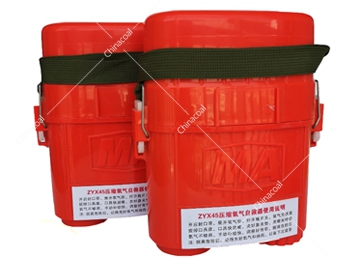Mining Self-Rescuers: Your Lifeline in Underground Emergencies
Date:2025-05-13 Label:
Shandong Day Shield Security & Rescue Equipment Manufacturing Co.
Ltd
Overview
A
mining self-rescuer (also called a self-contained self-rescue device, SCSR) is a portable respiratory protection device designed to provide miners with breathable air in emergency situations, such as fires, explosions, or toxic gas leaks. These devices are critical for escape when oxygen levels are low or hazardous gases (like carbon monoxide, methane, or hydrogen sulfide) are present.

Types of
mining self-rescuers
Filter Self-Rescuers (FSRs)
Use chemical filters to remove toxic gases (e.g., CO) while allowing oxygen to pass.
Typically provide 30–60 minutes of protection.
Lightweight and compact but rely on ambient oxygen.
Oxygen-Generating Self-Rescuers (SCSRs)
Produce breathable oxygen through a chemical reaction (usually potassium superoxide).
Can operate in oxygen-deficient environments (e.g., after a mine fire).
Offer 30–120 minutes of life-saving air supply.
Compressed Air Self-Rescuers
Carry a small tank of compressed breathable air.
Used in some high-risk mining operations.
Provide 10–60 minutes of air, depending on tank size.
Key Features
Compact & Lightweight – Easy to carry on a miner’s belt or harness.
Quick Activation – Can be deployed in seconds during an emergency.
Heat & Flame Resistance – Designed to withstand high temperatures.
One-Time Use – Most are disposable after activation.
Regulatory Compliance – Meets MSHA (U.S.), ATEX (EU), and other global safety standards.
How It Works
Activation – The user opens the device (usually by breaking a seal or pulling a tab).
Chemical Reaction (for SCSRs) – Potassium superoxide reacts with exhaled CO₂ and moisture to generate oxygen.
Filtration (for FSRs) – Toxic gases are absorbed while oxygen passes through.
Breathing – The miner breathes through a mouthpiece or mask while escaping.
Applications
Underground Coal Mining (high risk of methane and CO exposure).
Metal & Mineral Mining (potential for toxic gas leaks).
Tunneling & Construction (emergency escape in confined spaces).
Industrial Safety (chemical plants, oil rigs, and confined-space work).
Conclusion
Mining self-rescuers are a vital last line of defense for miners facing life-threatening air hazards. Advances in materials and oxygen generation continue to improve their reliability, ensuring safer escape routes in emergencies.



